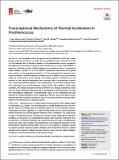Por favor, use este identificador para citar o enlazar a este item:
http://hdl.handle.net/10261/342969COMPARTIR / EXPORTAR:
 SHARE SHARE
 CORE
BASE CORE
BASE
|
|
| Visualizar otros formatos: MARC | Dublin Core | RDF | ORE | MODS | METS | DIDL | DATACITE | |

| Título: | Transcriptional Mechanisms of Thermal Acclimation in Prochlorococcus |
Autor: | Alonso-Sáez, Laura; Palacio, Antonio S; Cabello, Ana María CSIC ORCID; Robaina-Estévez, Semidán; Reyes-González, José M. ; Garczarek, Laurence; López-Urrutia-Lorente, Ángel | Palabras clave: | Prochlorococcus cyanobacteria marine thermal acclimation Transcriptomics |
Fecha de publicación: | 27-jun-2023 | Editor: | ASM International | Citación: | mBio 14(3) : 03425-22 (2023) | Resumen: | Low temperature limits the growth and the distribution of the key oceanic primary producer Prochlorococcus, which does not proliferate above a latitude of ca. 40°. Yet, the molecular basis of thermal acclimation in this cyanobacterium remains unexplored. We analyzed the transcriptional response of the Prochlorococcus marinus strain MIT9301 in long-term acclimations and in natural Prochlorococcus populations along a temperature range enabling its growth (17 to 30°C). MIT9301 upregulated mechanisms of the global stress response at the temperature minimum (17°C) but maintained the expression levels of genes involved in essential metabolic pathways (e.g., ATP synthesis and carbon fixation) along the whole thermal niche. Notably, the declining growth of MIT9301 from the optimum to the minimum temperature was coincident with a transcriptional suppression of the photosynthetic apparatus and a dampening of its circadian expression patterns, indicating a loss in their regulatory capacity under cold conditions. Under warm conditions, the cellular transcript inventory of MIT9301 was strongly streamlined, which may also induce regulatory imbalances due to stochasticity in gene expression. The daytime transcriptional suppression of photosynthetic genes at low temperature was also observed in metatranscriptomic reads mapping to MIT9301 across the global ocean, implying that this molecular mechanism may be associated with the restricted distribution of Prochlorococcus to temperate zones. IMPORTANCE Prochlorococcus is a major marine primary producer with a global impact on atmospheric CO2 fixation. This cyanobacterium is widely distributed across the temperate ocean, but virtually absent at latitudes above 40° for yet unknown reasons. Temperature has been suggested as a major limiting factor, but the exact mechanisms behind Prochlorococcus thermal growth restriction remain unexplored. This study brings us closer to understanding how Prochlorococcus functions under challenging temperature conditions, by focusing on its transcriptional response after long-term acclimation from its optimum to its thermal thresholds. Our results show that the drop in Prochlorococcus growth rate under cold conditions was paralleled by a transcriptional suppression of the photosynthetic machinery during daytime and a loss in the organism's regulatory capacity to maintain circadian expression patterns. Notably, warm temperature induced a marked shrinkage of the organism's cellular transcript inventory, which may also induce regulatory imbalances in the future functioning of this cyanobacterium. | Versión del editor: | https://doi.org/10.1128/mbio.03425-22 | URI: | http://hdl.handle.net/10261/342969 | DOI: | 10.1128/mbio.03425-22 | ISSN: | 2161-2129 |
| Aparece en las colecciones: | (IEO) Artículos |
Ficheros en este ítem:
| Fichero | Descripción | Tamaño | Formato | |
|---|---|---|---|---|
| Alonso-saez-et-al-2023-transcriptional-mechanisms-thermal-acclimation.pdf | 1,25 MB | Adobe PDF |  Visualizar/Abrir |
CORE Recommender
PubMed Central
Citations
1
checked on 23-abr-2024
SCOPUSTM
Citations
1
checked on 30-abr-2024
WEB OF SCIENCETM
Citations
1
checked on 27-feb-2024
Page view(s)
11
checked on 01-may-2024
Download(s)
6
checked on 01-may-2024

